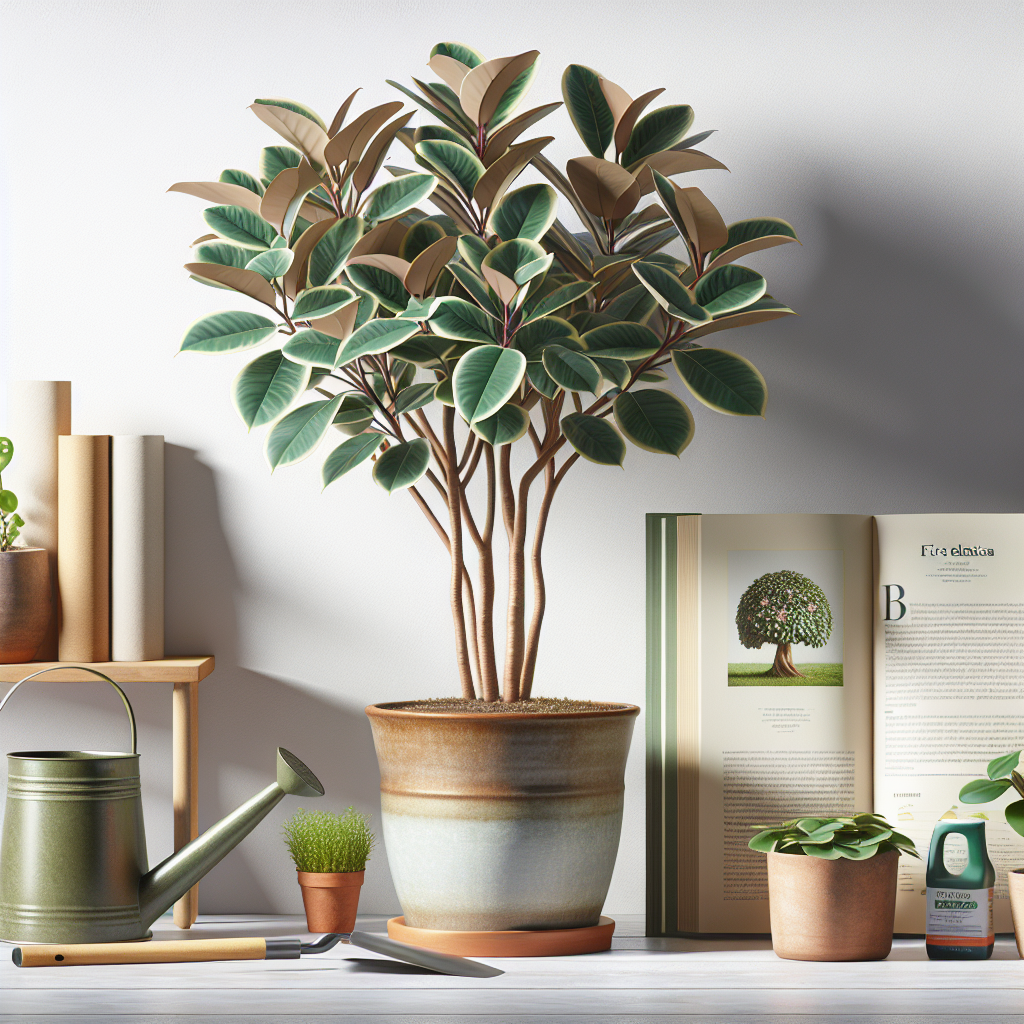How to Successfully Cultivate an Indoor Ficus Elastica
Updated July 9, 2024 at 3:18 am

Introduction to Indoor Ficus Elastica Care
- Pet Friendly: Ficus elastica (also known as Rubber Plant or Rubber Tree) is unfortunately toxic to pets if ingested. Keep it out of reach for cats and dogs.
- Light Requirements: Prefers bright, indirect light but can tolerate lower light conditions. Avoid direct sunlight, which can scorch its leaves.
- Watering: Water when the top inch of soil feels dry, usually every 1-2 weeks. Avoid overwatering to prevent root rot.
- Humidity: Enjoys moderate to high humidity. Mist the leaves regularly or use a humidifier to maintain ideal conditions.
- Temperature: Thrives in room temperatures between 60°F to 75°F (15°C to 24°C). Avoid sudden temperature changes and drafts.
- Difficulty: Known to be a low-maintenance plant, making it suitable for gardeners of all levels.
Selecting the Perfect Spot for Your Ficus Elastica
When it comes to growing a thriving Ficus elastica indoors, location is key. You might be wondering where to place your plant so it can grow tall and robust. Aim for a spot that receives plenty of bright, indirect light – near a north or east-facing window is ideal. If the only available light source is too intense, consider using sheer curtains to diffuse the light, or place the plant a few feet away from the window.
Choosing the Right Potting Mix
The right soil can mean the difference between a flourishing Ficus elastica and one that struggles. A well-draining potting mix is essential, as these plants dislike sitting in wet soil. Marketing gimmicks aside, try a blend specifically designed for indoor trees or a general potting mix amended with perlite or pumice for enhanced drainage. One such recommended product is FoxFarm Ocean Forest Potting Soil. It’s a potent mix full of earthworm castings, bat guano, and sea-going fish and crab meal, which seems to be a well-rounded feast for houseplants like Ficus elastica. Reviewers rave about its ability to retain moisture while still offering good drainage, which closely mimics the native growing conditions the Ficus elastica prefers.
Find This and More on Amazon
Proper Watering Technique for Ficus Elastica
Overwatering is a common misstep that can put your Ficus elastica at risk. To keep your plant happily hydrated without waterlogging it, check the top inch of the soil before watering. If it’s dry, it’s time to water. Make sure your pot has drainage holes and let the excess water flow out. You might be fascinated to try a moisture meter to take the guesswork out of this. Sonkir Soil pH Meter is a tool that does just that, with the added benefits of testing soil pH and light levels. This handy device is praised for its ease of use and accuracy, guiding plant owners to water their Ficus elastica at just the right time.
Find This and More on Amazon
The Importance of Humidity and How to Increase It
As a tropical native, Ficus elastica thrives in a humid environment. Yet, indoor air, especially in the winter, can be quite dry. It’s suggested that people have success using a pebble tray filled with water placed beneath the plant pot, or using a humidifier to add moisture to the air around the plant. Some seasoned plant-keepers mention using the Levoit Humidifier, which has rave reviews for its silent operation and large capacity, making it a perfect ally in creating a lush, green haven for your Ficus elastica and other tropical plants.
Feeding Your Ficus Elastica
Feeding your plant is also crucial. A balanced liquid fertilizer can do wonders during the growing season (spring and summer). A product like Miracle-Gro Indoor Plant Food is highly recommended due to its ease of use—simply apply directly to the soil every 2 weeks—and the noticeable improvement in plant health and growth. People seem to love its gentle formulation which minimizes the risk of fertilizer burn, making it a safe choice for your Ficus elastica.
Pruning and Shaping Your Ficus Elastica
Pruning isn’t just about maintaining the aesthetics of your Ficus elastica, it’s also about encouraging healthy growth. Knowing when and how to prune is key. You’ll want to remove any dead or damaged leaves, and you can trim back any too-long branches to encourage a bushier growth pattern. Make sure your pruning tools are sharp and clean to prevent infection. The Fiskars Softgrip Bypass Pruner is frequently suggested for this task. Its comfortable grip and precision-ground blades earn it high marks among users for clean and easy cuts that promote healthy regrowth.
Find This and More on Amazon
Addressing Common Issues with Ficus Elastica Leaves
Keeping your Ficus elastica leafy and vibrant might come with its set of challenges. If you notice the leaves browning or dropping, it could be due to improper watering or lighting conditions. Brown spots usually speak to overwatering, while leaf drop might signify a larger issue such as a draft, low temperatures, or even pests. Ensure you’re evaluating all environmental factors if this occurs. For pest control, consider an organic insecticidal soap like Safer Brand Insect Killing Soap, which has become a go-to for many plant lovers. Its gentle formula is safe for plants but effective in dealing with common pests that might trouble your Ficus elastica, and it’s noted for keeping the leaves shiny and clean as a bonus.
When and How to Repot Your Rubber Plant
Ficus elastica grows quite fast and will need repotting every few years to ensure it doesn’t become root-bound. The right time to repot is generally in the spring, before the growth season starts. Look for signs such as roots growing through the drainage holes or soil that dries out too quickly after watering. When repotting, upsizing the pot is usually beneficial, giving it sufficient space to expand. Choose a container with ample drainage holes and fresh potting mix to give your plant a new lease on life. If you’re unsure of which pot to choose, the Honeysuckle Planter from Bloem is a favorite among garden enthusiasts due to its durability, aesthetically pleasing design, and built-in drainage system.
Adapting to Seasonal Changes
Your Ficus elastica will experience different growth phases with the seasons. In the warmer months, it will grow more actively, requiring more frequent watering and feeding. During winter, it’s a different story; growth slows down, and so should your watering schedule. Keep a close eye on your plant as seasons transition to adjust care appropriately. A consistent temperature away from cold drafts or heating vents will help your Rubber Plant adapt to the changes without too much stress.
Creating the Ideal Propagation Environment
Propagation can be a joyous process if done correctly. To propagate your Ficus elastica, select a healthy, non-woody stem and make a clean cut just below the node. Place the cutting in water or directly into soil, ensuring you’ve used rooting hormone to facilitate growth. Keeping the cuttings in a warm, humid place away from direct sunlight is crucial for successful propagation. Some find the use of a propagation station like the Mkono Plant Terrarium beneficial for maintaining the ideal humidity and temperature. Users love its stylish appearance and how it provides a clear view of the rooting process.
Utilizing Growth Enhancers and Supports
If you’re aiming for a tall, tree-like Ficus elastica, using a stake or moss pole can offer the necessary support for your plant as it grows. Start this process while the plant is relatively young to guide its upright growth. Velcro plant ties or soft string can be used to gently secure the plant to the support. Additionally, using a growth enhancer can stimulate a robust and healthy plant. Products like Superthrive Vitamin Solution have been heralded for aiding in root development and stress reduction after repotting or during environmental changes.
Caring for Your Ficus Elastica Throughout the Year
Taking care of a Ficus elastica is a year-round commitment that can be incredibly rewarding, as long as you remain attentive to the needs of your indoor tree. Each season brings different requirements for care. Spring signals a time for growth—this may be the perfect time to repot or start fertilizing as your plant awakens from the slower winter period. The summer months typically call for more frequent watering and feeding, coinciding with your Ficus elastica’s most active growth. During fall, begin to ease up on watering as the plant prepares to rest for winter. And in those cooler months, your plant will need less water and no fertilizer as it enters dormancy. Stay on top of these seasonal demands, and you could be the proud owner of a healthy, robust Ficus elastica for years to come.
Protecting Your Ficus Elastica from Diseases and Pests
Preventative care is often the best defense when it comes to keeping your Ficus elastica free from diseases and pests. Regularly inspecting the leaves for signs of distress, such as spotting or unexpected wilting, can alert you to issues before they escalate. If you do encounter pests, early treatment is key. Aphids, mealybugs, and spider mites are common culprits, and a quality insecticidal soap can be a great organic choice for treatment. One insecticide with positive reviews for efficacy and ease of use is the Bonide Insecticidal Super Soap. It is preferred by many for its ready-to-use spray bottle, and because it tackles a variety of pests without harming the plant. Maintaining a clean environment, proper watering, and adequate sunlight will also deter pest and disease problems, keeping your Ficus elastica thriving.
Getting to Know Your Ficus Elastica: Q&A
When immersing yourself in the care of a Ficus elastica, questions will naturally arise. Is it normal for leaves to drop off? Yes, occasional leaf drop is a part of the natural growth process, but excessive loss can point to issues with watering or light. How fast do they grow? In optimal conditions, your plant can grow quite quickly—up to 24 inches per year. What are those dark spots on the leaves? Those could be signs of overwatering—make sure to let the soil dry out between waterings. Knowledge is power, and the more you understand about your indoor Rubber Plant, the better equipped you’ll be to respond to its needs for a long and leafy life.
Embracing the Community of Ficus Elastica Enthusiasts
The world of houseplants is not only about the plants themselves but also about the community that comes with them. There are numerous forums and social media groups dedicated to Ficus elastica care where you can share tips, triumphs, and even troubleshoot problems with fellow enthusiasts. Exchanging knowledge and experiences can enrich your own journey with your indoor tree and provide a sense of connection with those who share your passion for plants. It’s comforting to know that you’ve got a wealth of collective wisdom to tap into as you grow alongside your Ficus elastica.
Nurturing Your Relationship with Your Ficus Elastica
The act of caring for a living plant such as the Ficus elastica can be much more than a hobby—it’s a relationship. As you tend to your Rubber Plant, observing its unique characteristics and responding to its needs, you’ll develop a connection that’s rooted in patience, attentiveness, and appreciation. By nurturing this bond, you not only encourage a thriving indoor green space but also cultivate your own sense of well-being, grounding, and joy in the daily rituals of plant care. Welcome to the fulfilling world of Ficus elastica cultivation—a journey filled with growth, learning, and natural beauty.
Shop more on Amazon

